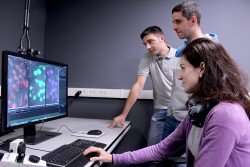Alchemists of the cell environment

To analyse, understand, interfere, and correct. Researching about life machinery goes through deciphering how cells, the smaller alive units within an organism, work. Being healthy depends mainly on adequate behaviour of our cells. In fact, nowadays it is well established that many diseases (such as cancer) start when malfunctioning is occurring inside them.
Thus, to diagnose and treat those diseases it is strictly necessary to puzzle out the molecular keys that drive the cellular machinery, developing tools and technologies that allow us to alter the cellular behaviour in a controlled and predictable manner. This is one of the main objectives of Prof. J. L. Mascareñas' research group at CiQUS. In fact, one of their research lines involves the design of metal-based chemical catalysts that can be used as enzymes right after internalisation in the living cell (enzymes are those proteins capable of accelerating most of the processes occurring in the body tissues). In other words: to create artificial enzymes that will promote reactions which are not taking place spontaneously in living organisms.
This work is part of the METBIOCAT European Project, led by Prof. Mascareñas and funded by an Advanced Grant from the European Research Council (ERC). Previously, Mascareñas' research group had shown the possibility of using ruthenium-based catalysts to promote chemical transformations in vivo, also controlling chemical reactions at will in specific cell organelles, such as the mitochondria.
At the moment, CiQUS scientists have communicated to the distinguished publication Nature Communications a new type of chemical transformation promoted by gold catalysts, which increases the chances to get new bioactive compounds within the living cell in a fully controlled manner. And that, because in this case chemical reactions are just taking place when this brand new catalyst is at play.
Suitable catalysts
This work was completely developed at the CiQUS laboratories by the following research group: the postdoctoral researcher Cristian Vidal, the 'Juan de la Cierva' fellow María Tomás, the Ph.D. student Paolo Destito, and the CSIC tenure scientist Fernando López, under the supervision of Prof. José Luis Mascareñas.
"This is the first demonstration of a gold catalyst working inside a living cell," Dr. López says. However, there is further improvement coming from this work: in the first author's words, Cristian Vidal: "As soon as we confirmed that the new gold catalyst was working, the consequent goal was to combine its activity with that of a second metal catalyst, a ruthenium complex previously developed by us." Indeed, this challenge was satisfactory reached, as María Tomás highlights: "We demonstrate that both catalysts can work together simultaneously, without interfering with each other, inside the same cell."
In the words of Prof. Mascareñas, "we have set the first example to create an artificial metabolism, fully compatible with natural ones and, obviously, inspired by the activity of enzymes." This work paves the way for designing new treatments based on the controlled and synchronised activation of several drugs, also having different therapeutic activities from each other.
More information: Cristian Vidal et al. Concurrent and orthogonal gold(I) and ruthenium(II) catalysis inside living cells, Nature Communications (2018). DOI: 10.1038/s41467-018-04314-5
Journal information: Nature Communications
Provided by CORDIS


















